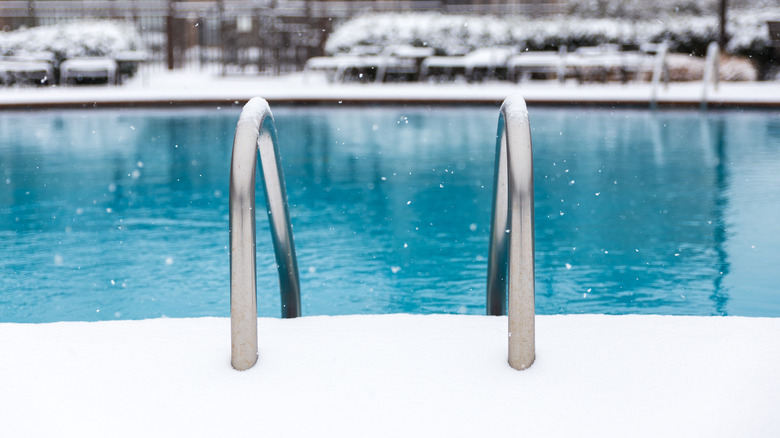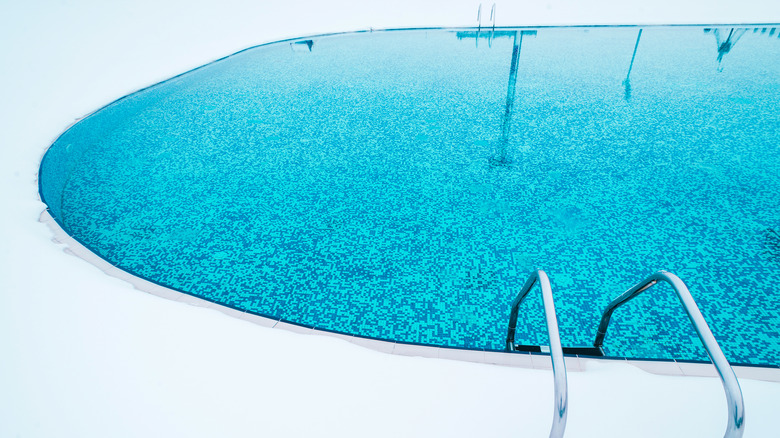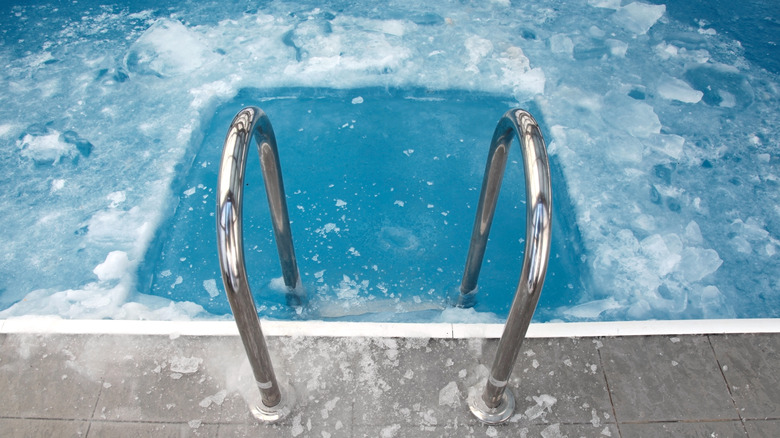What Happens To Your Swimming Pool When You Don't Winterize It?
When Winter Storm Uri swept the United States in 2021, it set records for some of the worst temperatures ever reported. It also caused unprecedented damage, with State Farm insurance claims for frozen pipes reaching $471 million, according to Insurance Journal. Cold weather will wreak havoc on a plumbing system when the water inside freezes and expands, causing cracks and leaks. Swimming pools are particularly vulnerable during a deep freeze because the equipment can easily be damaged if it has not been winterized properly. What does it mean to winterize a swimming pool? Most importantly, it means draining the water from all lines in the system.
When Winter Storm Uri hit, many homeowners living in moderate climates felt unprepared because they had never winterized their pools. In many states, people keep their swimming pools open all year long. It's not unusual to swim on a warm day in October or March in Texas. Some people may even turn on the heat in their pools and swim all year round. But after the storm passed, they faced the aftermath – and the expense — of their lack of preparation. What happens to a swimming pool when it's not winterized? Here are a few of the consequences.
Ice can harm the equipment
A pool pump is a piece of equipment that will naturally wear out over time, and experts recommend replacing it every 8 to 12 years, via Water Level Controls. However, if icy water expands inside this system, the mechanism could begin to leak and no longer pump water effectively. If this happens, replacing the pump sooner than expected may become necessary. The average cost of replacing a pool pump is around $440, although this cost can run much higher for a larger pool and different kinds of pumps. The same is true for the pool filter. If ice expands inside this system, it may cause cracks in the tank, valve, or clamp. The cost to replace a filter could range between $1,100 and $1,300, according to USA Today.
Neglecting to winterize your pool can also cause damage to the pool heater and pipes, via Pool Parts to Go. The cost to replace a couple of lines can be about $450, and installing a new pool heater is estimated at around $3,600 (per USA Today). In addition to the cost of the repairs is the wait time required to receive new parts. This waiting period stems from the high volume of work needing to be done across the country, coupled with a delay in the availability of some items.
Ice can damage the deck
In addition to the mechanical systems, freezing weather will also impact the pool structure and the deck surrounding the pool (states Pool Parts to Go). With an above-ground pool, the expanding ice may cause the pool casing to stretch beyond its capacity, which could ultimately cause the structure to collapse, damaging the skimmer. With an inground pool, the tiles or deck can crack from ice expansion. If a pipe underneath the deck breaks, reaching the line and repairing it will be costly.
Fortunately, winterizing a pool helps you avoid these expensive repairs. Tyler Detota is the lead pool technician in Knoxville, Tennessee, at Able Gunite Pools and Spas. According to USA Today, his advice will save every pool owner a lot of repair work and heartache. "If you hear about cold, cold weather coming, get it winterized immediately," he advises. The good news is that winterizing a pool only requires about an hour to complete. He recommends starting the process early before the temperatures drop below freezing. "Do it when it's in the 30s," he suggests. If in doubt, contact a professional to help with the winterizing process. Taking the time to prepare your swimming pool for freezing weather is good for your home and peace of mind, and it will be worth the effort when warm weather arrives, and your sparkling pool is ready to be enjoyed again.


